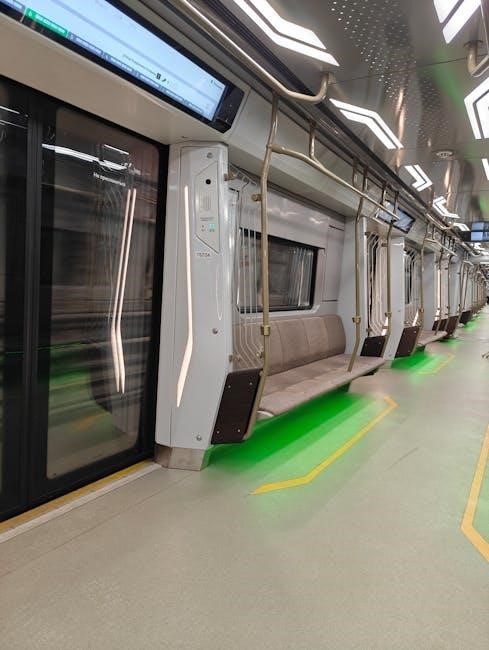Linear guide rails and carriages are essential components in linear motion systems, enabling smooth and precise movement. Designed for high performance, they are widely used across industries.

Overview of Linear Motion Systems
Linear motion systems are designed to enable movement along a straight path, providing precision and control in various industrial applications. These systems consist of components like rails, carriages, and bearings, which work together to support loads and facilitate smooth operation. Linear motion is critical in machinery, robotics, and automation, where accuracy and reliability are paramount. The systems are engineered to handle different types of loads, from light to heavy, and offer features such as low friction, high rigidity, and resistance to wear. By integrating advanced materials and manufacturing techniques, modern linear motion systems ensure durability and efficiency, making them indispensable in sectors like manufacturing, aerospace, and medical equipment.
Importance of Linear Guide Rails and Carriages
Linear guide rails and carriages play a vital role in enabling precise and smooth linear motion in industrial applications. They are fundamental to machinery and equipment, providing stability and support for moving components. By minimizing friction and wear, these systems enhance operational efficiency and extend the lifespan of machinery. Their importance lies in their ability to handle heavy loads while maintaining high accuracy, making them indispensable in industries such as manufacturing, aerospace, and medical equipment. The reliability and durability of linear guide rails and carriages ensure consistent performance, reducing downtime and maintenance costs. Their contribution to modern engineering is crucial, supporting advancements in automation and robotics.

Types of Linear Guide Rails

Linear guide rails are categorized into ball bearing, roller bearing, and plain bearing types, each offering unique advantages in load capacity, precision, and friction reduction.
Ball Bearing Linear Guide Rails
Ball bearing linear guide rails are the most common type, offering high precision and smooth motion. They use recirculating balls within the carriage to minimize friction and maximize load capacity. These systems are ideal for applications requiring high accuracy and durability. The balls are designed to roll smoothly along the rail, ensuring consistent movement and reducing wear. Ball bearing guides are widely used in CNC machines, robotics, and aerospace due to their ability to handle heavy loads and maintain precise positioning. They are particularly suited for high-speed operations and are available in various sizes to accommodate different application needs. Their reliability and performance make them a preferred choice in industrial settings.
Roller Bearing Linear Guide Rails
Roller bearing linear guide rails are designed for heavy-duty applications, offering superior load capacity and rigidity. They utilize cylindrical rollers within the carriage, which provide excellent stability and resistance to moment loads. These systems are ideal for high-torque and large-scale industrial machinery. The rollers distribute the load pressure more evenly compared to ball bearings, making them suitable for applications requiring robust performance. Roller guides are commonly used in construction equipment, heavy-duty robotics, and large CNC machines. While they may operate at lower speeds than ball bearing systems, their durability and ability to handle substantial forces make them a reliable choice for demanding environments. This ensures precise and consistent movement even under extreme conditions.
Plain Bearing Linear Guide Rails
Plain bearing linear guide rails, also known as sliding or non-rolling guide rails, operate without rolling elements like balls or rollers. Instead, they rely on sliding motion between the carriage and rail, often requiring lubrication for smooth operation. These systems are simple in design, cost-effective, and suitable for light to medium loads. Plain bearings are ideal for applications where noise reduction and low maintenance are prioritized. They are commonly used in manual or low-speed linear motion systems, such as in medical equipment or laboratory devices. While they may lack the high precision of ball or roller bearings, plain bearing guides offer reliability in specific industrial and lightweight applications. Their simplicity makes them a practical choice for straightforward linear motion needs.

Components of Linear Guide Systems
Linear guide systems consist of rails, carriages, bearing elements, end stops, and wipers, ensuring smooth motion and load support in various applications.
The Rail Component
The rail component is a precision-engineered track that provides the guiding path for the carriage. Typically made from high-quality steel or aluminum, it ensures durability and resistance to wear. The rail’s surface is often hardened to maintain accuracy and minimize friction. Available in various designs, such as square or round profiles, the rail is selected based on the application’s load requirements and desired motion type. Proper alignment and installation of the rail are critical for smooth operation. Cleaning and lubrication are essential to maintain its performance and longevity. The rail’s design allows for integration with bearings, enabling seamless linear motion in industrial systems.
The Carriage Component
The carriage component is a movable part that travels along the rail, providing a mounting platform for payloads or machinery. It houses the bearing elements, such as balls or rollers, which enable smooth motion. Carriages are designed to withstand varying loads and operational stresses, ensuring precise alignment and stability. They are typically constructed from durable materials like steel or aluminum for longevity. Proper installation and maintenance of the carriage are crucial to ensure optimal performance and extend service life. The carriage’s design varies depending on the application, with options for high-load capacity, low friction, or specialized environments. Its reliability is central to the overall functionality of linear guide systems.
Bearing Elements (Balls or Rollers)
Bearing elements, such as balls or rollers, are critical components within linear guide systems. These elements facilitate smooth motion by reducing friction between the carriage and the rail. Balls are commonly used for their high precision and low torque requirements, making them ideal for applications requiring exact positioning. Rollers, on the other hand, are preferred in scenarios involving heavy loads due to their larger contact area, which distributes force more effectively. Both types are typically made from high-quality steel or ceramic materials to ensure durability and resistance to wear. Proper lubrication and maintenance of these elements are essential to maintain optimal performance and extend the lifespan of the system. Their design and material selection directly impact the overall efficiency and reliability of the linear guide.
End Stops and Wipers
End stops and wipers are essential accessories for linear guide systems, ensuring safe and efficient operation. End stops are mechanisms that limit the travel of the carriage along the rail, preventing over-travel and potential damage to the system. They can be mechanical, such as bumpers or stops, or electronic, using sensors to detect the carriage’s position. Wipers, on the other hand, are components that clean the rail by removing debris, dust, and contaminants, ensuring smooth movement and preventing wear. Both are crucial for maintaining the longevity and performance of the linear guide system, particularly in harsh or dirty environments. Proper installation and maintenance of these elements are vital for reliable operation.

Materials and Manufacturing
Linear guide rails and carriages are typically made from high-strength materials like steel, aluminum, or stainless steel for durability. Advanced manufacturing processes ensure precision and smooth operation.
Materials Used for Rails and Carriages
Linear guide rails and carriages are typically constructed from high-quality materials such as steel, aluminum, or stainless steel, ensuring durability and resistance to wear. Steel is often chosen for its strength and high load-bearing capacity, while aluminum offers lightweight and corrosion-resistant properties. Stainless steel is ideal for harsh environments due to its superior corrosion resistance. Some systems also incorporate specialized coatings or treatments to enhance performance and longevity. The choice of material depends on the application’s specific requirements, such as load capacity, environmental conditions, and desired lifespan. High-performance materials ensure smooth operation and reliability in industrial and precision applications.
Manufacturing Processes for Precision
The manufacturing of linear guide rails and carriages involves precise processes to ensure high accuracy and durability. Advanced machining techniques, such as precision grinding and milling, are employed to achieve tight tolerances and smooth surfaces. The rails are often hardened through heat treatment or surface coating to enhance wear resistance. CNC machining is commonly used to maintain consistency and precision in producing complex geometries. Additionally, advanced surface finishing techniques, such as grinding and polishing, are applied to minimize friction and ensure smooth movement. Quality control measures, including rigorous inspection and testing, are implemented to guarantee optimal performance. These processes ensure that the final products meet stringent industrial standards for reliability and precision.

Advantages of Linear Guide Rails
Linear guide rails offer high precision, high load capacity, and smooth operation, making them ideal for applications requiring accurate and consistent linear motion with minimal friction.
High Precision and Repeatability
Linear guide rails are renowned for their ability to deliver high precision and repeatability in linear motion systems. This is achieved through the use of recirculating ball or roller bearings, which minimize play and ensure consistent movement. The square rail design provides exceptional stability, reducing deflection and ensuring accurate positioning. These features make linear guide rails ideal for applications requiring tight tolerances, such as CNC machines, robotics, and precision manufacturing. The precise machining of both the rail and carriage ensures smooth, repeatable motion, while the rolling elements maintain consistent contact with the rail. This combination enables reliable performance in demanding environments where accuracy is critical.
High Load Capacity
Linear guide rails are designed to handle high load capacities, making them suitable for heavy-duty applications. The use of robust materials and advanced bearing technologies ensures that these systems can withstand significant forces without compromising performance. Roller bearing guide rails, in particular, are known for their ability to support heavy loads due to their larger contact area compared to ball bearings. The square rail design further enhances load distribution, allowing for even weight transfer and minimizing the risk of deflection. This makes linear guide rails ideal for industries requiring robust machinery, such as aerospace, automotive manufacturing, and material handling systems. Their durability ensures reliable operation under demanding conditions.
Low Friction and Smooth Movement
Linear guide rails and carriages are engineered to provide low friction and smooth movement, ensuring efficient operation in various applications. The use of rolling elements, such as balls or rollers, minimizes contact resistance, allowing the carriage to move effortlessly along the rail. This design reduces wear and tear, prolonging the system’s lifespan. The precise alignment and high-quality materials further contribute to a seamless motion experience. Low friction is particularly beneficial in applications requiring consistent velocity and precise positioning, such as CNC machines and robotics. By minimizing energy loss and vibrations, these systems deliver reliable performance, making them indispensable in industries where smooth operation is critical.

Applications of Linear Guide Rails
Linear guide rails are widely used in CNC machines, robotics, aerospace, medical equipment, and industrial automation, enabling precise and smooth motion in diverse industrial applications.
CNC Machines and Robotics
Linear guide rails and carriages play a pivotal role in CNC machines and robotics, enabling precise and repeatable movements. In CNC machining, these systems ensure accurate positioning of cutting tools, allowing for intricate designs and high-quality finishes. Robotic arms rely on linear guides to perform tasks requiring extreme precision, such as assembly, welding, and material handling. The use of ball-bearing or roller-bearing systems in these applications ensures smooth, low-friction motion, even under heavy loads. Their durability and resistance to wear make them ideal for continuous operation in industrial environments, contributing to increased productivity and consistency in manufacturing processes.
Aerospace and Defense
Linear guide rails and carriages are critical in aerospace and defense applications, where precision and reliability are paramount. They are used in systems like satellite positioning, radar antennas, and missile guidance, ensuring smooth and accurate movement. The Roll-Slide Mini carriage and rail systems, for instance, are employed in defense applications for their compact design and durability. These components are designed to withstand harsh environments, including extreme temperatures and vibrations, while maintaining high performance. Their low friction and high load capacity make them ideal for systems requiring consistent operation. The RK DuoLine 120 Z, with its timing-belt-driven mechanism, is another example used in aerospace for precise linear motion. Such systems are essential for ensuring the accuracy and reliability of critical defense equipment.
Medical and Laboratory Equipment
Linear guide rails and carriages play a vital role in medical and laboratory equipment, where precision, cleanliness, and reliability are essential. They are used in devices such as patient examination tables, medical imaging systems, and laboratory automation tools. For instance, the TW-01-30 model is designed to be resistant to dust, dirt, and moisture, making it ideal for sterile environments. The drylin W modular system is another example, offering a clean and low-maintenance solution for medical applications. These systems provide smooth, low-friction movement, enabling accurate positioning and consistent performance. Their compact designs and high stiffness also make them suitable for laboratory equipment that requires precise linear motion. Such components are crucial for ensuring the accuracy and reliability of medical and laboratory devices.

Installation and Maintenance
Proper alignment and lubrication are critical for installation. Regular cleaning and inspection of rails and carriages ensure longevity. Use end stops and wipers to protect systems from damage.
Step-by-Step Installation Guide
For a successful installation of linear guide rails and carriages, follow these steps:
Ensure the rail is clean and properly aligned. Use shims if necessary for precise alignment.
Secure the rail to the base using bolts, ensuring it is level.
Attach the carriage to the rail, ensuring proper engagement. Lubricate the bearings as specified.
Install end stops and wipers to protect the system from overtravel and contaminants.
Test the system for smooth movement and adjust if needed. Proper installation ensures optimal performance and longevity.
Maintenance Tips for Longevity
Regular maintenance is crucial for extending the lifespan of linear guide rails and carriages. Start by lubricating the bearings and rails to reduce friction and wear. Clean the rail surfaces and carriage regularly to remove dirt and debris. Inspect the system for misalignment and adjust if necessary. Replace worn or damaged components promptly to prevent further damage. Check and replace wipers and end stops to ensure proper protection against contaminants and overtravel. Finally, follow the manufacturer’s guidelines for lubrication intervals and part replacement to maintain optimal performance and longevity.
Linear guide rails and carriages are vital for precise, smooth motion in various industries. Their durability, versatility, and high performance make them indispensable in modern machinery and robotics.

Linear guide rails and carriages are critical components in linear motion systems, providing precise and smooth movement. They are available in various types, including ball, roller, and plain bearing systems, each suited for specific applications. These systems are widely used in industries like CNC machining, robotics, aerospace, and medical equipment due to their high load capacity, low friction, and durability. Proper installation and maintenance are essential to ensure longevity and optimal performance. As technology advances, compact and high-performance designs are emerging, offering improved efficiency and versatility for future applications.
Future Trends in Linear Guide Technology
Future trends in linear guide technology focus on miniaturization, increased precision, and integration with smart systems. Compact and lightweight designs are gaining traction, reducing power consumption while maintaining high stiffness. Modular systems, such as those with interchangeable components, are becoming popular for flexibility. Advances in materials, like corrosion-resistant and self-lubricating options, are expected to enhance durability. Additionally, the development of curved and adaptive guide systems will expand application possibilities. Integration with automation and IoT technologies will enable real-time monitoring and predictive maintenance, improving efficiency. These innovations aim to meet the growing demand for high-performance, customizable linear motion solutions across industries.





